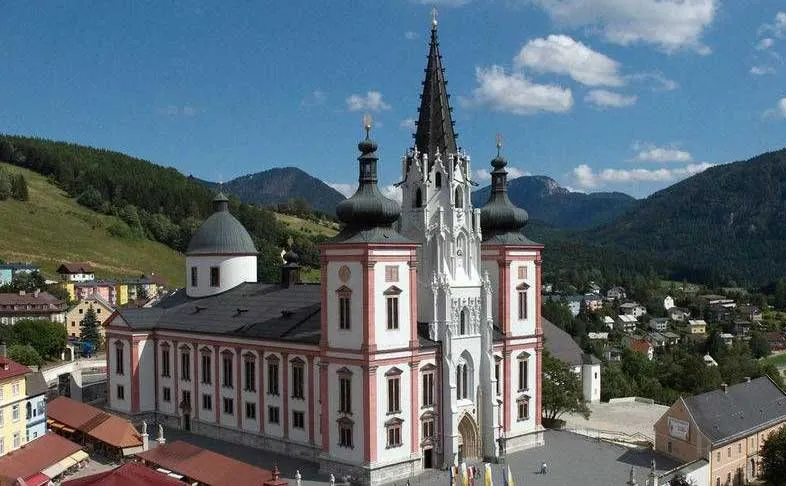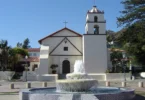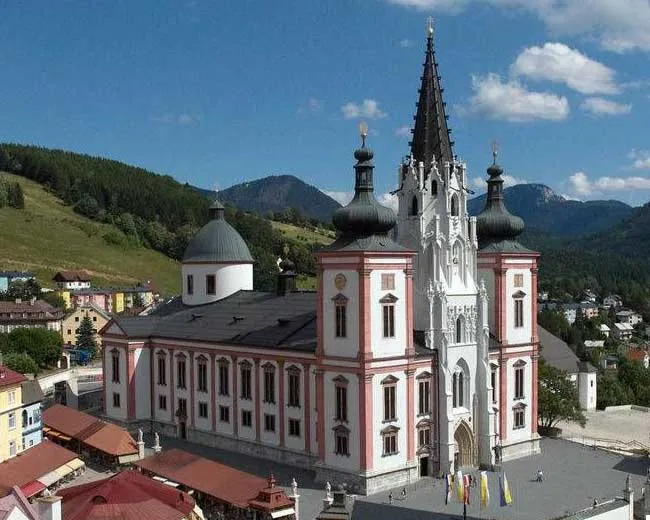
Introduction
Mariazell Basilica, Austria also known as Basilica Mariä Geburt (Basilica of the Birth of the Virgin Mary), is a Roman Catholic church building in Mariazell, is a city in the southeastern state of Styria, Austria. It is the most important pilgrimage destination in Austria and one of the most visited shrines in Europe. In the church, a miraculous wooden image of the Virgin Mary is venerated.
It is a site of pilgrimage for Catholics from Austria and neighboring countries. The object of veneration is an image of the Virgin Mary reputed to work miracles, carved in lime-tree wood.
Pope Pius X personally raised the sanctuary to the status of a minor basilica by a Motu proprio in 10 November 1907. Later, he ensured the coronation of the Marian image by a decree on 8 September 1908. Mariazell is the only church named as a national shrine of all German-speaking countries.
Known as the Great Mother of Austria, Our Lady of Mariazell provides guidance and provision. On September 27, 1992, the chapel honoring Mary under this title at the Basilica was dedicated by Bishop Egon Kapellari of Gurk-Klagenfurt, Austria. Today, we examine the history behind the Marian devotion of Mariazell and reflect upon how the Basilica honors its legacy of hope.
Mariazell is small town located in the Alpine Mountains of northern Austria, with a small population of just about 2,000 people. The Mariazell Basilica, or Basilica Mariä Gebur, is a Marian Shrine that is considered the most important Pilgrimage destination in Austria attracting about a million pilgrims each year. This basilica is also extremely important for Catholics in the Danube area and in Central Europe.
A Benedictine monk named Magnus was sent to look over the people living in Mariazell. On his journey, he brought a wooden statue of Virgin Mary from the Benedictine convent of St. Lambrecht. When his path was covered by a boulder, set the statue on the boulder and the rock miraculously split. Once in Mariazell, Magnus built a chapel around the statue, which is now the basilica. The statue is now worshiped as “Magnus Mater Austriae”, translated, the great mother of Austria.
The Mariazell area was presided over by the Monastery of St. Lambrecht beginning in 1102, however it wasn’t until 1266 that the Marian Altar was dedicated here. After building, destruction and rebuilding, the church became what we know as the baroque masterpiece, built in the mid-1600s, by famous Italian architect Domenico Sciassia.
In September of 1983, Pope John Paul II made a Pilgrimage to this stunning Basilica.
History of Mariazell Basilica, Austria

Mariazell Basilica, Austria – The territory around Mariazell was given to St. Lambert’s Abbey around 1103, and the monks built a cell in order to serve the local residents. Tradition gives the town’s founding day as December 21, 1157. A Marian altar was dedicated in 1266.
An inscription above the main portal, giving the date 1200, means that we can assume that the building of the Romanesque chapel began at this time. The first documentary evidence of ‘Cell’ is from the year 1243. A letter of indulgence, dated 1330, from Archbishop Friedrich III of Salzburg, is given as the source for the Church of Our Beloved Lady of Cell as a much visited place of pilgrimage. By 1344 the community had received the rights of a market town.
Of great importance for Mariazell was the awarding of a plenary indulgence by Pope Boniface IX in 1399. It was granted for the week following the octave of the Assumption of the Virgin and led to the cultivation of penitential rites and processions, which continued after the indulgence was revoked and are documented well into the baroque period. The stream of pilgrims constantly increased.
There were already around two dozen stalls for the sale of votive offerings by around 1400, and approximately one-hundred years later Mariazell was known internationally as a place of pilgrimage. Pilgrims from the regions of what are today Bavaria, Bohemia, France, Italy, Croatia, Poland, Germany, Switzerland, but above all, Austria and Hungary, were even then actively seeking the help of the Mariazell Mother of Mercy.
Mariazell Basilica, Austria / Mariazell enjoyed a special heyday after the end of the Counter Reformation as a national shrine of the House of Habsburg, which not only placed its personal fate under the protection of Mariazell, but the entire country and its inhabitants. The example given by the ruling family moved the members of the aristocracy and the bourgeoisie, and finally the peasantry, to make pilgrimages to Mariazell.
The Gothic church could no longer accommodate the great number of pilgrims and Abbot Benedikt Pierin of Saint Lambrecht decided upon a baroque expansion that gave the church its characteristic appearance.
The bestowal of city status in 1948 was not due to the size of the community, but its importance as an ecclesiastical and cultural centre acknowledged far beyond the borders of Austria. Since the fall of the Iron Curtain, it is now possible for pilgrims from Austria’s neighbouring countries to the south and east to again come unhindered to Mariazell.
Architecture of Mariazell Basilica, Austria
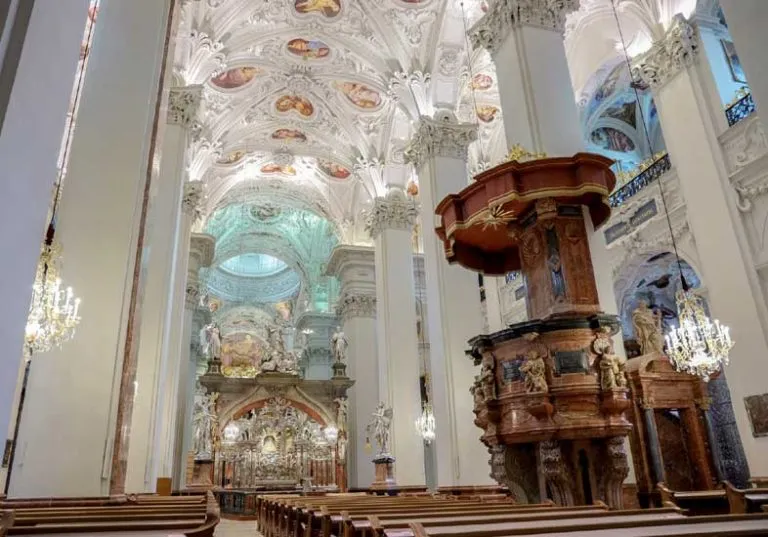
Mariazell Basilica, Austria – In the fourteenth century, a gothic church stood at Mariazell with a 90 m high spire and an ogive portal. In 1420 and 1474, the church was destroyed by fire. The church building was later expanded and redesigned in the Baroque style by Domenico Sciassia from 1644 to 1683. To the left and right of the gothic spire, a baroque tower was built, the nave was lengthened and widened, and a dome was added on the eastern side. The high altar, consecrated in 1704, was designed by Johann Bernhard Fischer von Erlach.
The twelve side chapels each contain a baroque altar. The plaster stucco work of the organ gallery and the 1737 organ console was created by the Viennese sculptor Johann Wagner in 1740.
In front of the main entrance are two life-sized lead statues created by Balthasar Moll in 1757. To the left stands King Ludwig I of Hungary and to the right is Heinrich, Margrave of Moravia.
In 1907, the pilgrimage church was elevated to a basilica minor.
The Mariazell Basilica, Austria has been undergoing a general restoration since 1992, which was completed in 2007.

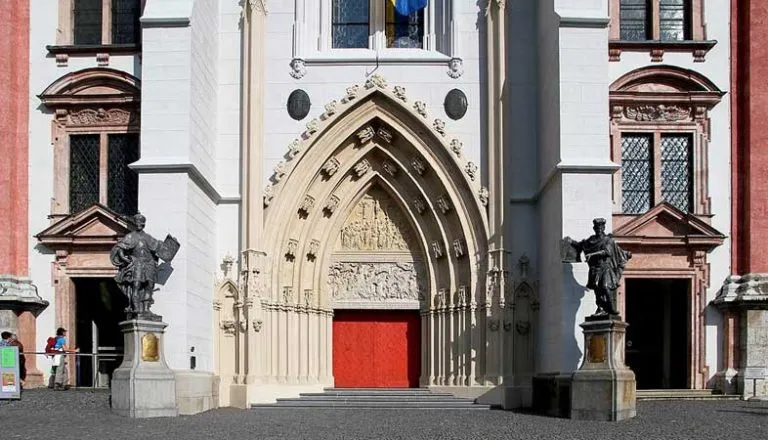
Holy Image and Chapel
The older part of the building, built in 1690, contains the Gnadenkapelle. This chapel sits on the site of the first “cell” and holds a Late Romanesque miraculous image of the Virgin Mary – the “Magna Mater Austria”, a 48 cm tall statuette made of linden.
The miraculous image receives an elaborately designed merciful dress every year. The more than 150 dresses can either be viewed in the treasury or are carefully conserved. Many clothes were donated as votive offerings or by wealthy people. The design of a mercy dress is still considered a great honor today.
Our Lady of Mariazell Chapel
Mariazell Basilica, Austria – This Marian devotion is honored in the Basilica in the Chapel of Our Lady of Mariazell, which was the first chapel to be donated to the Basilica by a country outside the United States. It is a gift of the Austrian Bishops Conference, the Austrian government, and Austrian-American Catholics.
The focal point of the chapel is an exact replica of the statue of Our Lady of Mariazell, made of linden wood and measuring only 19 inches tall. Mary holds a fig, symbolizing sin, while Jesus holds an apple, symbolizing redemption. The statue features a red seal, indicating that it was touched to the original and carries the same graces. The chapel also contains the crests of the nine provinces of Austria and bronze masks of St. Leopold II and St. Clement Maria von Hofbauer.
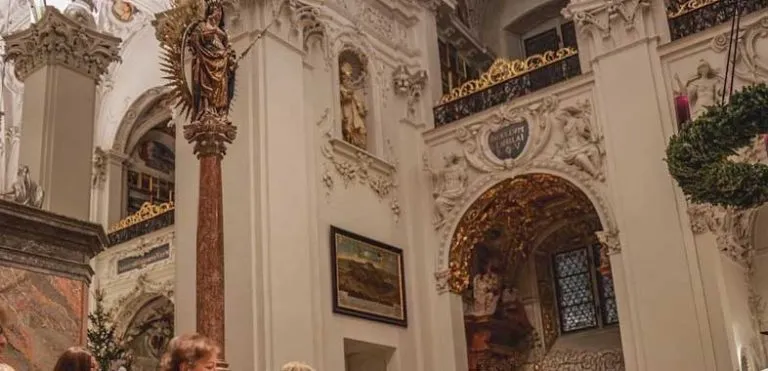
The Tradition of Our Lady of Mariazell
The tradition of the devotion to Our Lady of Mariazell dates back to 1157, when a miraculous event happened to a monk named Magnus. One day, when Magnus was traveling, he found his path barred by a vast boulder. Faced with this obstacle, he placed a small statue of Mary that he was carrying with him on the rock, and prayed for guidance.
To his astonishment, the rock split in two, allowing him to pass. After this miracle, he built a small cell (in German “zell”) in which to live and pray. Over time, it became a monastery and a church, which still stands as pilgrimage site for the faithful today.
Pilgrimage Development
Pilgrims were already making their way to the Marian sanctuary in the 12th century. Larger numbers of pilgrims are documented beginning around 1330, when a secular court imposed a Zellfahrt (Zell journey) as atonement for its criminals. In the following years increasing numbers of pilgrims came from neighboring lands.
After the Counter-Reformation, the Habsburgs made Mariazell a national sanctuary. However, in 1783, Emperor Joseph II abandoned the monastery in Mariazell, and in 1787, he completely banned pilgrimages to Mariazell. After the early withdrawal of the restrictions, around a million pilgrims visit Mariazell each year. In May 2004, the Mitteleuropäischer Katholikentag (Central European Catholic Day) took place in Mariazell.
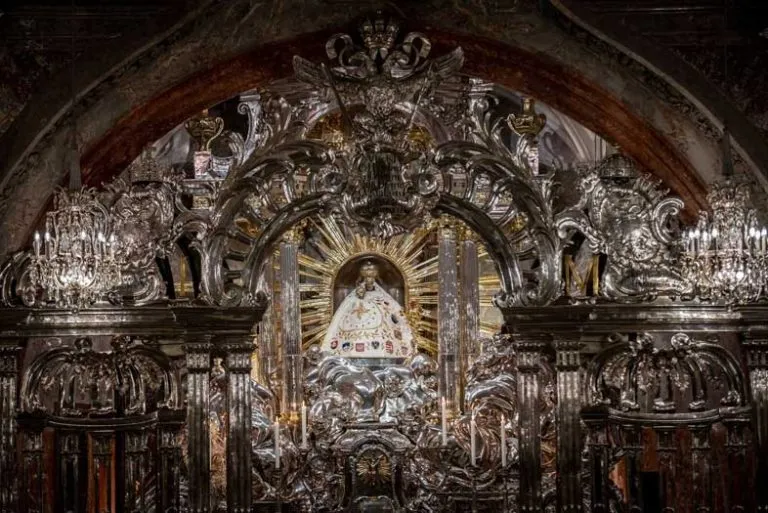
Legends
There are three basic legends about the founding of Mariazell and its development. The legend of the town’s founding says that in 1157, a monk of St. Lambrecht, called Magnus, was sent to the area of the current town as a minister. When his way was blocked by a rock, he set down the Marian figurine he had brought with him, whereby the rock broke apart and left Magnus’ way clear. On a nearby bank, he settled down, placed the figurine on a tree trunk, and built a cell out of wood, which served as both his chapel and his living quarters.
The second legend relates how Henry Margrave of Moravia and his wife, having been healed of severe gout by the help of Our Lady of Mariazell, made a pilgrimage to that place around 1200. There they had the first stone church built on the site of the wooden chapel.
The third legend recounts a victorious battle of the Hungarian King Ludwig I. over a numerically superior Turkish army. In thanks he built the gothic church and endowed it with the Schatzkammerbild (treasury image) that he saw laid upon his chest in a dream.
In 2007, the Mariazell Basilica was selected as the main motif of a collectors’ coin: the Austrian Mariazell Basilica commemorative coin, minted on May 9. The coin shows the facade of the basilica with its characteristic central gothic tower flanked by two baroque towers.
Our Lady of Zell (Mariazell), Austria
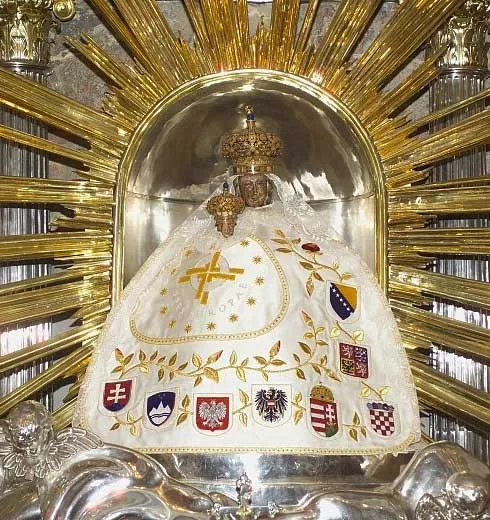
The places dedicated to Mary are the best proof that Mary gives help today to souls and bodies.
The glorious pilgrim church at Zell is nestled in the midst of the Styrian Mountains 50 miles southwest of Vienna. It is mantled in snow most of the winter and is the haven for skiers., is the Lourdes of central Europe. Since its founding, it has become the most popular Marian shrine in Austria, and there is a miraculous wooden statue of the Virgin Mary that is much venerated at the church.
According to tradition, there was once a Benedictine monk known as Magnus, who, in the year 1157, left his abbey at Lambrecht seeking a more contemplative life. As he was passing through a forest looking for a suitable place for his hermitage, he encountered a massive, black boulder that blocked his way. Magnus was stymied, as he could not continue in that direction, and so he took out a small statue of the Blessed Virgin that he kept with him. Placing the statue on a log, he knelt down to pray for guidance.
The heavenly assistance he requested was not long in coming, for the ground began to tremble, and with a loud crack, the boulder broke in two. A strange light emanated from the broken edges of the stone, revealing the miraculous cause of the break. Magnus realized at once that he had found the location of the hermitage he had been seeking, and placed his cherished statue on a stump and built a small shrine to display the miraculous statue. Pilgrims came to the place almost immediately as news of the miracle spread through the region.
One of the most famous and popular Marian Shrines in central Europe is found in the Styrian Mountains, 50 miles southwest of Vienna, Austria. Covered in snow for most of the winter months, it has become the Lourdes of the region. The miraculous wooden statue of the Blessed Virgin Mary has been venerated for centuries, where it resides today.
The story of Our Lady of Mariazell begins in the middle of the 12th century with a Benedictine monk by the name of Magnus. To focus on a more contemplative life, this man left his Benedictine abbey. While traveling and looking for a place to build his hermitage, he came upon a massive bolder, which blocked him from continuing on further.
Desiring to continue in this direction, Magnus removed a small statue of the Blessed Virgin from his belongings, put the statue on a log nearby, and began to pray for direction. Within moments, a miraculous thing happened – the earth trembled, a loud crack was heard, and rays of light came forth from the boulder – the large rock broke into two pieces. At that point, the monk realized this was the spot for his hermitage. He immediately began to build a small shrine around the wooden statue. As news spread of this miracle, pilgrims began to show up.
The statue that once belonged to Magnus and can still be viewed today is known as Magna Mater Austriae. The statue is slightly over 18 inches and is housed in the Chapel of Miracles. The statue is the Mother of God holding in her arms the Child Jesus. The Infant Jesus holds in his hands an apple, the fruit most associated with the Fall of Man, which He would redeem on the Cross. Our Lady of Mariazell is also known as – The Great Mother of Austria, The Great Lady of Hungary, and the Great Mother of the Slavic People.
Our Lady of Zell - Magnus’ Statue
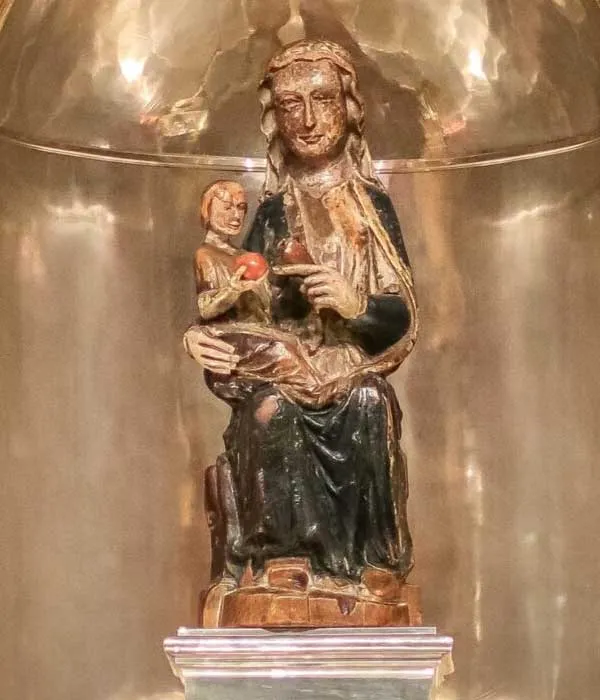
Magnus’ statue, known as the “Magna Mater Austriae,” can still be viewed. It is just over 18 inches tall, and is kept in what is called the Chapel of Miracles, which is located above the very place where Magnus had made his monastic cell. The statue depicts the Mother of God holding the Divine Child in her arm. The baby Jesus holds an apple, recalling the fall of man and his later redemption. The statue is also known as the Great Mother of Austria, the Great Lady of Hungary, and the Great Mother of the Slavic People.
This first small shrine was enlarged with a church in the year 1200, and was further expanded in 1335 after King Henry I had been granted a miraculous cure after being told in a dream to go to Our Lady of Zell. King Louis the Great of Hungary had the Mariazell Basilica built in the year 1363, which is also known as the Basilica of the Birth of the Virgin Mary, in gratitude for a military victory he won over a numerically superior army of Turks: 20,000 men against 80,000 Turks.
The church he had built was of Gothic style, and in 1377, King Louis I added a chapel called the Gnadenkappelle, the Chapel of Grace. The church was damaged by fire in 1420 and again in 1474, but then expanded again in the 17th century, and is the same church that stands today.
The various peoples of the broad Danubian area have made Our Lady of Zell the goal of their pilgrimages. Jewels, crowns, and garments were brought to the Great Mother at Zell. Untold thousands of Austrians, Hungarians, Croats, Slovenes, Czechs have knelt there before Mary’s image, each feeling that his race was under the special protection of Mary.
A lamp of pure silver burns before the altar. It is the gift of the Empress Maria Theresa. She was mother of a great empire and brought her sorrow to Mariazell to the Mother of God. No castle of Our Lady was more honored and enriched by the Hapsburghs.
The great Cardinal Mindszenty was buried at Mariazell, Our Lady of Zell, in 1975.
Countless miracles have taken place on the spot for the peoples of the region. Pilgrims from Austria, Hungary, Croatia, Slovakia, and Czechoslovakia, as well as pilgrims from around the world have knelt before the image of Our Lady. Jewels, crowns, and holy garments have been brought to the Great Mother of Zell.
Historically, the shrine has been blessed with numerous kingdoms involved with its development. King Henry I received a miraculous cure after going to Zell. King Louis the Great of Hungary attributes Our Lady’s intercession to his victory over the Turks in the late 14th century. Due to her grief being relieved from the Great Lady, the Hapsburghs Empress, Maria Theresa, gave a gift to the shrine – a lamp of pure silver, which burns before the altar.
It is estimated that around one million pilgrims make their way to the shrine of Our Lady of Mariazell, which over the years has been built, added upon, rebuilt due to fires and finally expanded to the current structure today. In 1907, Pope Saint Pius X elevated the shrine to a Minor Basilica and crowned the statue. On the nights before the feasts of The Assumption of Mary (August 15), The Nativity of the Blessed Virgin Mary (September 8), and on Our Lady of Mariazell (September 13), great processions are made to the shrine.

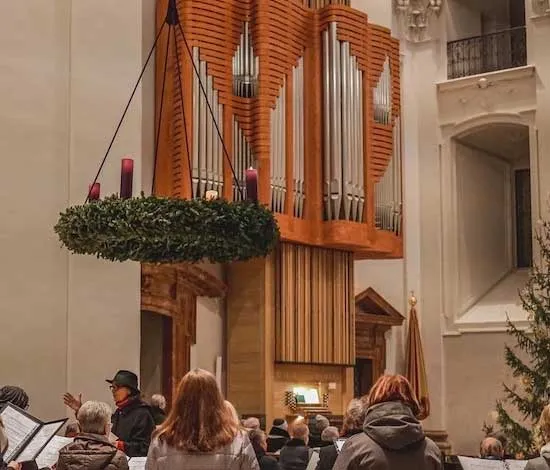
Feast Day – 13th September
Annual Feast of Our Lady of Mariazell is held on 13th September.
Mass Time
May 1st to October 31st
Weekdays
6:00 am, 7:00 am, 8:00 am, 10:00 am, 11:15 am, 6:30 pm
Sundays
8:00 am, 8:30 am, 9:30 am, 10:00 am, 11:15 am, 6:30 pm
November 1st to April 30th
Weekdays
7:00 am, 8:00 am, 11:15 am, 6:30 pm
Sundays
8:00 am, 8:30 am, 9:30 am, 11:15 am, 6:30 pm
Church Visiting Time
Contact Info
Mariazell Basilica,
Benedictus Square 1,
8630 Mariazell, Austria
Phone No.
Tel : +43 3882 25950
Accommodations
How to reach the Basilica
Mariazell lies on the highway B 20, which goes from St. Pölten over the Seebergsattel to Kapfenberg im Mürz Valley. There is a connection through the Salza Valley to the east either over the Gscheid to St. Aegyd am Neuwalde, into the Piesting Valley und then further into the Viennese Basin (B 21) or over the Lahnsattel into the Mürz Valley and onward to Mürzzuschlag (B 23).
Mariazell is also the southern endpoint of the Mariazell railway line, a narrow gauge electric railway from St Pölten. However the terminus of the line at Mariazell station lies around 1 km (0.6 mi) north of the city center in the municipal territory of Sankt Sebastian. The station is also the terminus of the Museumstramway Mariazell-Erlaufsee, a standard gauge heritage steam tramway that operates to the nearby Erlaufsee.
Vienna International Airport is the international airport of Vienna, the capital of Austria, located in Schwechat, 18 km southeast of central Vienna and 57 kilometres west of Bratislava is the nearby airport to the Basilica.

